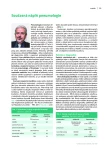Pneumonia in immunocompromised persons
Authors:
Jana Skřičková
Authors‘ workplace:
Klinika nemocí plicních a TBC LF MU a FN Brno, pracoviště Bohunice
Published in:
Vnitř Lék 2017; 63(11): 786-795
Category:
Reviews
Overview
In the broadest sense, the term immunocompromised individual means a person with any impairment of infection resistance, whether it is deficiency or impairment of innate resistance (by another name impairment of non-specific resistance), or impairment of acquired resistance (impairment of specific immunity). Pneumonia in immunocompromised patients is characterized by a different microbiological spectrum. Apart from common pathogens there are also opportunistic agents involved in this group of patients. Management of pneumonia in immunocompromised patients is often decisive for their future fate. Very rare are innate immune deficiencies. Acquired immune deficiencies are far more common. They are often combined with disorders of non-specific resistance. The most frequent cause of acquired immune deficiency is another illness or a medical treatment. The diagnosing and treatment of pneumonias in immunocompromised patients are usually highly specialized and they unquestionably require a collaboration with microbiologists who are concerned with these problems.
Key words:
diagnostics – etiology – pneumonia in immunocompromised patients – prophylaxis – treatment
Sources
1. Mayer J, Skřičková J, Vorlíček J. Postižení plic u imunokompromitovaných nemocných. Diferenciální diagnostika a využití bronchoalveolární laváže. IDVPZ: Brno: 1995. ISBN 80–7013–199–3.
2. Votava M, Jindrák V. Mikrobiologická diagnostika pneumonií a její interpretace. In: Ševčík P, Skřičková J, Šrámek V et al. Záněty plic v intenzivní medicíně. Galén: Praha 2004. ISBN 80–7262–278–1.
3. Fishman JA, Rubin RH. Infection in organ-transplant recipients. New Engl J Med 1998; 338(24): 1741–1751.
4. Pohlreich D. Febrilní neutropenie u dospělých pacientů s maligním onemocněním. Postragudální medicína 2010; 12(9): 993–1001.
5. Snopková S, Chalupa P. Postižení plic u infekce HIV/AIDS. In: Ševčík P, Skřičková J, Šrámek Vet al. Záněty plic v intenzivní medicíně. Galén: Praha: 2004. ISBN 80–7262–278–1.
6. Skřičková J, Mayer J, Vorlíček J et al. Využití bronchoalveolární laváže v diagnostice infekčního postižení plic u imunokompromitovaných nemocných. Remedia Klinická mikrobiologie 1999; 3(3): 80–86.
7. Hausfater P, Garric S, Ben Ayed S et al. Usefulness of procalcitonin as a marker of systemic infection in emergency department patients: a prospective study. Clin Infect Dis 2002; 34(7): 895–901.
8. Decramer M, Roussos C. Imaging in lung disease. Eur Respir J Suppl 2002; 35:1s-2s.
9. Skřičková J, Votava M, Jindrák V et al. Projevy zánětů plic a jejich vyšetřování. In: Ševčík P, Skřičková J, Šrámek V et al. Záněty plic v intenzivní medicíně. Galén: Praha 2004.
10. Straus J. Pulmonary Endoscopy and Biopsy Techniques. European Respiratory Society Journals: 1998. ISBN 978–1904097105.
11. Dooms C, Seijo L, Gasparini S et al. Diagnostic bronchoskopy: state of the art. Eur Respir Rev 2010; 19: 117, 229–236. Dostupné z DOI: <http://dx.doi.org/10.1183/09059180.00005710>.
12. Bulpa PA, Dive AM, Mertens L et al. Combined bronchoalveolar lavage and transbronchial lung biopsy: safety and yield in ventilated patients. Eur Respir J 2003; 21(3): 489–494.
13. Tasbakan SM, Gurgun A, Basoglu O et al. Comparison of Bronchoalveolar Lavage and Mini-Bronchoalveolar Lavage in the Diagnosis of Pneumonia in Immunocompromised Patients. Respiration 2011; 81(3): 229–235. Dostupné z DOI: <http://dx.doi.org/10.1159/000323176>.
14. Marik PE. Handbook of Evidence-Based Critical Care. Springer; New York-Berlin- Heidelberg 2001. ISBN 978–0387951539.
15. Kocmanová I. Invazivní mykotické infekce. Onkologie 2014; 8(4): 167–168.
16. Haber J, Vašáková M, Mallátová N et al. Plicní aspergilové syndromy – diagnostika a léčba, doporučené postupy odborných společností. Studia Pneumologica et Phthiseologica 2016; 76(3): 82–106.
17. Dellinger RP, Levy MM, Carlet JM et al. Surviving Sepsis Campaign: International Guidelines or Management of Severe Sepsis and Septic Shock: 2008. Crit Care Med 2008; 36(1): 296–327. Erratum in Crit Care Med 2008; 36(4): 1394–1396.
18. Murray JF, Nadel JA. Textbook of Respiratory Medicine. 6th ed. Saunders: Philadelphia 2015. ISBN 978–1455733835.
Labels
Diabetology Endocrinology Internal medicineArticle was published in
Internal Medicine

2017 Issue 11
Most read in this issue
- Spirometry – basic examination of the lung function
- Non-invasive ventilation
- Small-cell lung cancer: epidemiology, diagnostics and therapy
- Pneumonia in immunocompromised persons
